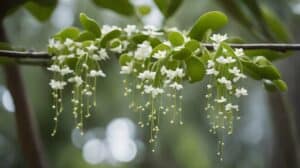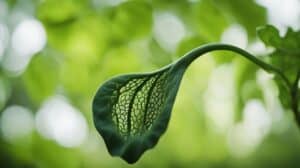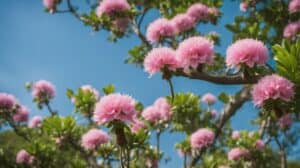The Cedrus Atlantica, commonly known as the Atlas Cedar, is a majestic tree that is native to the Atlas Mountains of Morocco and Algeria.
Its towering height, striking blue-green needles, and impressive cones make it a popular choice for landscaping and ornamental purposes.
However, caring for this tree can be a challenge, especially for beginners.

In this article, we will provide some helpful tips on how to care for the Cedrus Atlantica and interesting facts about this beautiful tree.
Whether you are a seasoned gardener or a beginner, these tips will help you keep your Atlas Cedar healthy and thriving.
So, let’s dive in and discover the beauty of this magnificent tree.
Getting to Know Cedrus Atlantica
Origins and Natural Habitat
Cedrus Atlantica, also known as the Atlas cedar, is a species of coniferous tree native to the Atlas Mountains of Morocco and Algeria.
It is a popular ornamental tree in many parts of the world due to its striking appearance and hardiness.
In its natural habitat, Cedrus Atlantica thrives in mountainous regions with cool, wet winters and hot, dry summers.
It can grow up to 40-60 feet tall and has a spread of around 20-40 feet.
Physical Characteristics
The Cedrus Atlantica has a distinctive appearance, with blue-green needles that grow in clusters of 30-40.
The needles can reach up to 1 inch in length and are arranged in a spiral pattern around the branches.
The tree also produces cones that are around 3-4 inches in length and have a unique shape.
Cedrus Atlantica is a slow-growing tree, with an average growth rate of around 12 inches per year.
It prefers well-draining soil and full sun exposure, but can tolerate some shade.
Overall, the Cedrus Atlantica is a beautiful and hardy tree that can add a touch of elegance to any landscape.
With proper care and maintenance, it can thrive for many years to come.
Planting and Initial Care

Choosing the Right Location
Before planting a Cedrus Atlantica, it is important to choose the right location. This tree requires full sunlight and well-drained soil.
It is best to avoid planting it in areas with poor drainage or where it may be exposed to strong winds.
Soil Requirements and Preparation
Cedrus Atlantica prefers a slightly acidic soil with a pH of 5.5 to 6.5. Before planting, it is recommended to test the soil to determine its pH level.
If the soil is not within the ideal range, it can be adjusted by adding lime or sulfur.
To prepare the soil for planting, it is important to remove any weeds or debris. The soil should be loosened to a depth of at least 18 inches.
Adding compost or other organic matter can also help improve soil quality and provide nutrients for the tree.
Planting Procedure
To plant a Cedrus Atlantica, dig a hole that is twice as wide as the tree’s root ball and slightly shallower than the depth of the root ball.
Place the tree in the hole and backfill with soil, making sure to tamp down the soil to remove any air pockets.
Water the tree thoroughly after planting and add a layer of mulch around the base to help retain moisture and suppress weeds.
It is important to provide regular water for the first year after planting, especially during hot and dry periods.
Avoid overwatering, as this can lead to root rot. Fertilizer can be applied in the spring and fall to provide additional nutrients for the tree.
Pruning can also be done to remove any dead or damaged branches and to shape the tree as desired.
By following these planting and initial care tips, beginners can ensure the success of their Cedrus Atlantica tree.
Ongoing Maintenance and Care

Watering Essentials
Cedrus Atlantica requires moderate watering. It is important to ensure that the soil is moist but not waterlogged.
Overwatering can lead to root rot, which can be detrimental to the tree’s health.
Watering should be done regularly, especially during the summer months when the tree is actively growing.
Pruning and Shaping
Pruning is an important aspect of maintaining the health and shape of Cedrus Atlantica.
It is recommended to prune the tree in the late winter or early spring before new growth begins.
This will allow for the removal of any dead or damaged branches and promote healthy growth.
Shaping can also be done during pruning to maintain the desired shape of the tree.
It is important to note that Cedrus Atlantica should not be heavily pruned as it can lead to stress and damage to the tree.
Pest and Disease Management
Cedrus Atlantica is generally resistant to pests and diseases.
However, it is still important to monitor the tree for any signs of infestation or disease.
Common pests include spider mites and scale insects.
These can be managed through regular monitoring and the use of insecticidal soap or horticultural oil.
Diseases such as needle blight and canker can also affect Cedrus Atlantica. These can be managed through proper pruning and sanitation practices.
It is important to remove any infected branches and dispose of them properly to prevent the spread of disease.
Overall, with proper watering, pruning, and monitoring, Cedrus Atlantica can thrive and add beauty to any landscape.
Fun Facts and Environmental Benefits

Cultural Significance
The Cedrus Atlantica has been revered for centuries due to its cultural significance. The tree is often associated with strength, durability, and nobility.
In ancient times, the wood of the Cedrus Atlantica was used to construct temples, palaces, and other important structures.
Today, the tree is still highly valued for its wood, which is used to make furniture, flooring, and other high-end products.
Ecological Impact
The Cedrus Atlantica has several environmental benefits that make it an important tree to plant and protect.
One of the most notable benefits is its ability to prevent soil erosion.
The tree’s deep roots help to hold soil in place, which can be especially important in areas that are prone to landslides or erosion.
In addition to preventing soil erosion, the Cedrus Atlantica is also known for its air-cleaning properties.
The tree’s needles absorb pollutants from the air, helping to improve air quality in the surrounding area.
Finally, the Cedrus Atlantica provides important habitat for a variety of wildlife species.
The tree’s branches and needles provide shelter and nesting sites for birds, while the tree’s bark and wood provide food and habitat for insects and other small animals.
Overall, the Cedrus Atlantica is an important tree that provides a variety of cultural and environmental benefits.
By planting and protecting these trees, individuals can help to preserve these benefits for future generations.
Frequently Asked Questions

What are the best practices for watering and fertilizing a Blue Atlas Cedar?
Blue Atlas Cedars require moderate watering and should be watered deeply once a week during the growing season.
It is important to avoid overwatering as this can lead to root rot. Fertilization should be done in the spring using a balanced fertilizer.
How can I identify and treat common diseases affecting Blue Atlas Cedars?
Blue Atlas Cedars are susceptible to a few common diseases such as needle blight and canker.
Symptoms of these diseases include needle discoloration and branch dieback. Treatment involves pruning affected branches and applying fungicides.
It is important to maintain good air circulation around the tree to prevent these diseases from developing.
What should I know about the growth rate and mature size of Atlas Cedars?
Blue Atlas Cedars have a slow to moderate growth rate and can reach a mature height of up to 40 feet and a spread of up to 30 feet.
They are typically pyramidal in shape with a broad base and narrow top.
How do I properly prune a Blue Atlas Cedar to maintain its shape and health?
Pruning should be done in late winter or early spring before new growth appears.
It is important to only remove dead or diseased branches and to avoid over-pruning as this can lead to stress and damage to the tree.
Pruning should be done in a natural, open form to maintain the tree’s shape and health.
Can you describe the root system of a Blue Atlas Cedar and how it affects planting location?
Blue Atlas Cedars have a shallow and spreading root system that requires well-drained soil.
It is important to avoid planting near structures or sidewalks as the roots can cause damage.
They also prefer full sun and should be planted in an area with good air circulation.
Where can I find a Weeping Blue Atlas Cedar for purchase and what should I consider before buying?
Weeping Blue Atlas Cedars can be found at nurseries and garden centers.
Before buying, consider the mature size of the tree and ensure that it will fit in the desired planting location.
It is also important to ensure that the tree is healthy and free of any diseases or pests.














